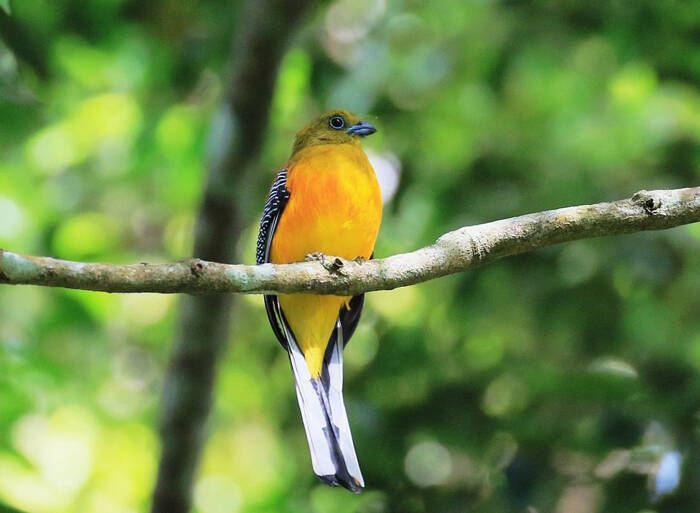Harpactes oreskios
IUCN
LCBasic Information
Scientific classification
- name:Harpactes oreskios
- Scientific Name:Harpactes oreskios,Orange-breasted Trogon
- Outline:Climbing birds
- Family:Trogonidae
Vital signs
- length:31-36cm
- Weight:91-110g
- lifetime:No verification information
Feature
Poor flying ability, fast but not far
Distribution and Habitat
Distribution in the world: Breeding from the Arctic coast of Siberia to the Bering Strait, the extreme north of North America, western Europe and western Greenland. Wintering in North America, Mexico, the Caspian Sea, the Black Sea, the Mediterranean, Central Asia, India, Myanmar, Japan and North Korea.
Distribution in China: Wintering in the middle and lower reaches of the Yangtze River in China, the southeast coast and Taiwan. During migration, it is distributed in Northeast China, Inner Mongolia, North China, Xinjiang, Tibet and other places. The nominate subspecies has been recorded in Northeast China, Shandong and Hebei during migration. The wintering area is in the Yangtze River Basin and the provinces of East China to Hubei, Hunan and Taiwan. It is also found in southern Tibet. There are about 20,000 individuals in Poyang Lake in winter.
It mainly inhabits low mountain evergreen broad-leaved forests between 600-1500 meters above sea level, lives in tropical rain forests, e
Appearance
The upper and sides of the head of the male adult are dark red, and some specimens have less red on their heads and are mainly brown; the back and shoulders are brown, and the waist and tail coverts are brown chestnut. The central pair of tail feathers is chestnut with black feather tips; the base and the side of the feather shaft of the adjacent pair are chestnut, and the rest is black, and the next pair is completely black; the outermost 3 pairs are black with wide white tip spots, and the outer edge of the outermost pair is completely white. The small wing coverts are the same color as the back; the primary coverts are gray-black; the rest of the wings are black, and the remaining coverts, tertiary flight feathers and inner secondary flight feathers are densely covered with white insect-like fine horizontal stripes, and the outermost 7 flight feathers have white feather shafts and feather edges. The chin is light black; the throat to the chest is from bright red to dark red, and the
Details
Orange-breasted Trogon, also known as Orange-breasted Trogon, has 5 subspecies.

Orange-breasted Trogons often move alone or in pairs; they are arboreal, either climbing on the top branches of small trees to eat wild fruits, or standing quietly on tree branches waiting for an opportunity to pounce on flying insects, and occasionally following flying insects. They have poor flying ability and can fly fast but not far.
The breeding season of the Orange-breasted Trogon is from March to May. It nests in natural tree holes or digs holes on the remaining tree trunks to build nests. Each nest lays 2-4 eggs, which are light brown in color and round in shape. The incubation period is 17-19 days, with the male and female taking turns to incubate the eggs, and the chicks are late-maturing.
The Orange-breasted Trogon used to be one of China's main hunting birds, with a large population. Since 1985, due to environmental degradation and overhunting, the population has dropped sharply. According to the Asian Midwinter Waterbird Survey organized by the International Waterfowl Research Bureau in 1990, the number of wintering populations in China was only 2,170. According to global reports, from 1955 to 1974, the wintering population in North America was 200,000, Alaska and Canada were 250,000 and 55,000 respectively, mainly the Pacific subspecies; Europe was about 300,000 (Philippona 1972), mainly the nominate subspecies; the Canadian subspecies was estimated to be 1,800, the Alaskan subspecies was estimated to be 1,500, and the Greenland subspecies was estimated to be 12,000-15,000.
Listed in the 2012 Red List of Endangered Species of the World Conservation Union (IUCN) ver 3.1 - Least Concern (LC).
Listed in the second level of the List of Key Protected Wildlife in China.
Protect wild animals and stop eating game.
Maintaining ecological balance is everyone's responsibility!








